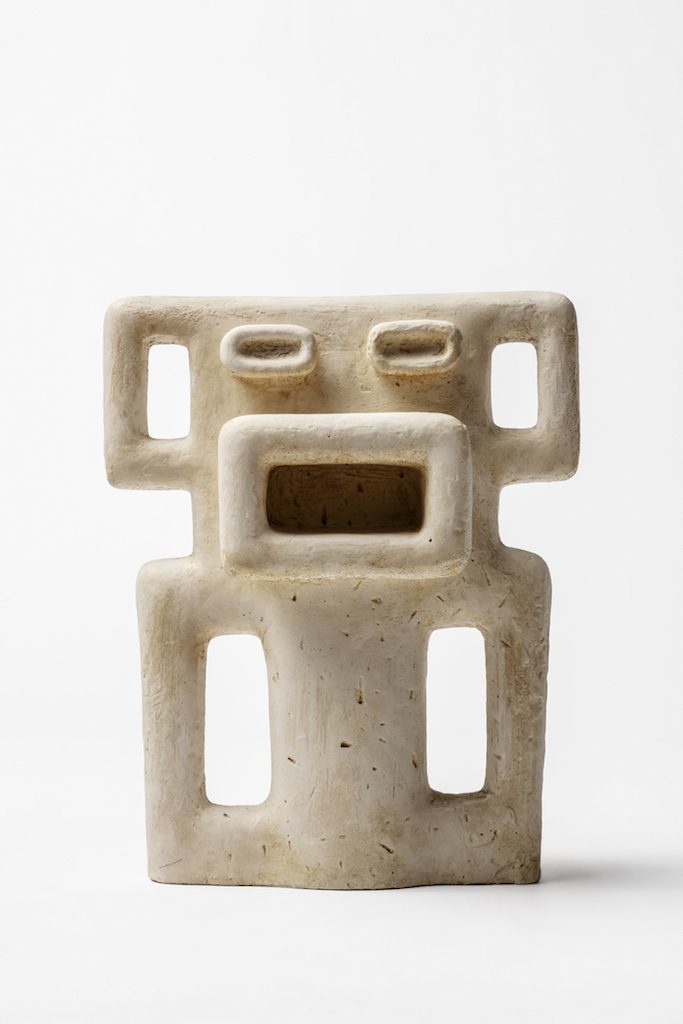Sonja Ferlov Mancoba’s abstract sculptures exhibited at the Pompidou Centre alongside Ernest Mancoba’s works
26/06/2019 - 23/09/2019S
outh-African artist Ernest Mancoba and Danish artist Sonja Ferlov Mancoba, exiled in Paris for almost the entire length of their respective careers, will be exhibited at the Centre Pompidou in Galerie O and the Galerie d’art graphique from June 26th to September 23rd 2019.
Married in Paris and sharing the same Parisian studio, Ernest Mancoba and Sonja Ferlov Mancoba will be given top billing by the Centre Pompidou in two distinct spaces, in order to pay tribute to the breadth of their practices, inseparable and yet singular.

Sculpture, 1940-46
Bronze.
© Centre Pompidou, MNAM-CCI/Audrey Laurans/ Dist. RMN-GP
© Adagp, Paris, 2019
This is the first full retrospective in France on the work of Sonja Ferlov Mancoba (1911-1984). Designed in collaboration with the SMK, National Gallery of Denmark in Copenhagen, the exhibition presents 58 sculptures and 67 drawings by this Danish artist still little known in France today. Starting in the 1930s, Sonja Ferlov Mancoba produced a body of sculptural and pictorial work that was both profoundly personal and at the same time connected to 20th-century Danish and international artistic movements. At the crossroads between abstract and figurative forms, her sculptures and drawings were created using a large body of references, from African and Pre-Colombian art to Surrealism. Anthropomorphic, her works unveil a way of seeing the individual as a being that is perpetually evolving, refashioning the body’s borders, both in terms of the material and metaphysical, formal and spiritual.

4 sculptures
Sans titre, 1957-59
Terre cuite.
Silkeborg, Museum Jorn. © Anders Sune Berg
© Adagp, Paris, 2019
Sonja Ferlov Mancoba first studied painting in 1931 and joined up with the new generation of Danish artists (Richard Mortenson, Ejler Bille, Hans Øllgaard and Vilhem Bjerke-Petersen). Founders of the Linien group in 1934 and its eponymous publication, they defended, alongside Sonja Ferlov, an emancipated and engaged art that connected abstraction and surrealism, and set down the guidelines for spontaneous abstract creation that later played a major role in the Scandinavian art scene during and after the war. After completing her first paintings, Sonja Ferlov turned towards sculpture, experimenting with clay or using objects found in nature.

In 1936, the artist moved to Paris. Enrolled at the Ecole nationale des beaux-arts, she rented a studio near that of Alberto Giacometti, with whom she became friends. Sonja Ferlov met Joan Miró, Max Ernst, Jean Arp and Sophie-Taeuber-Arp while preparing a Surrealist exhibition with her compatriots in Copenhagen.

Squelette de l’esprit, 1984 Plâtre
© Anders Sune Berg
© Adagp, Paris, 2019
Between 1937 and 1940 she created a collection of sculptures with organic shapes bordering on abstraction, introduced the theme of the mask in her work and started a series of drawings based on a complicated system of symbols. In 1939, Sonja Ferlov met the South-African artist Ernest Mancoba, whom she married in 1942. At the start of the War she moved to Denmark for a few months before returning to Paris to join Ernest Mancoba, who was not long after incarcerated in the Grande Caserne German prisoner-of-war camp in Saint Denis. During the war, she created Sculpture (1940-1946), a flagship piece that characterised her work method and was both spontaneous and rooted in a process of ongoing metamorphosis. Cast in plaster in 1946, Sculpture was the subject of a limited number of bronze editions, including a copy that was acquired by the Musée National d’Art Moderne in 2018.

Sans titre, vers 1935-36
Pastel sur papier, 32,5 x 28,5 cm Collection N. Stockmarr
© SMK Photo/Jakob Skou-Hansen © The estate of Ferlov Mancoba © Adagp, Paris, 2019
In 1947, one year after the birth of their son Wonga, the Ferlov-Mancoba couple moved to Denmark. Sonja exhibited with her former Linien comrades, as well as those who defended the spontaneous method, and they together created the international Cobra group in 1948 (Asger Jorn, Karel Appel and Carl-Henning Pedersen). Victims of racial intolerance in Denmark, in 1952, the family moved to the village of Oigny-en-Valois, to the northeast of Paris. Sonja Ferlov created little during this time but experimented with yellow clay and as of 1957 produced major sculptures that can be read as a reconfiguration and liberation of the human body.

Le combattant, 1961
Plâtre, collection particulière © Anders Sune Berg
© Adagp, Paris, 2019
The family moved definitively to Paris in 1961, where the artist undertook a series of very large sculptures. Her works included a variety of figures which, for some, refer to the sacred, where form blends in a dynamic of circulation and movement into an idea of a plural and composite being.

Bronze
© SMK Photo/Jakob Skou-Hansen © The estate of Ferlov Mancoba © Adagp, Paris, 2019
During the last decades of her life, Sonja Ferlov Mancoba regularly exhibited in her home country and occasionally in France. She enjoyed great success in Denmark and, in 1971, received the Thorvaldsen medal, one of the highest Danish distinctions for the visual arts. During these years, she continued to create works where the theme of duality appears in the form of masks and helmets. Emptiness became a central element in many of her sculptures – from every point of view.
Right up until her death in 1984, she continued to develop a body of work that transformed the individual into a transitory being, inscribed in a spiritual community and embodying the desire to counter a certain kind of western history, so dear to the bourgeoisie of her time.






